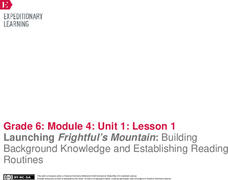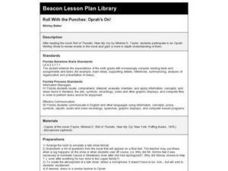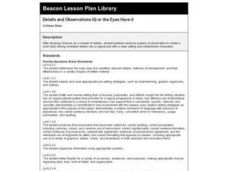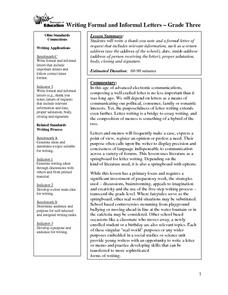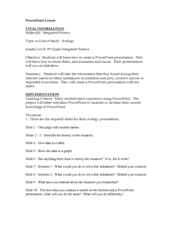EngageNY
Launching Frightful’s Mountain: Building Background Knowledge and Establishing Reading Routines
Welcome to Frightful's Mountain. The teacher introduces scholars to the text Frightful’s Mountain by reading the first chapter aloud. Learners then talk with a partner about the text. The instructor models answering focus questions...
Teaching English
Fairy Tales; Not Just for Kids
"Once upon a time . . ." Language learners examine the key elements of well-known fairy tales and then craft their own.
Curated OER
The Keeping Quilt
Pupils discover story analysis by discussing a book the class reads together. In this reading comprehension lesson, students read the book The Keeping Quilt and discuss the different characters and plot points among the...
Curated OER
Roll With the Punches: Oprah's On!
Sixth graders prepare questions for an Oprah Winfrey talk show featuring the characters from Roll of Thunder, Hear My Cry, the amazing novel by Mildred D. Taylor. Selected students role-play the characters and answer questions Oprah...
Curated OER
"Theseus and the Minotaur"
Students analyze the features of myths and legends. They read the myths "Theseus and the Minotaur" and "Orpheus and Eurydice," identify the myth story elements, evaluate each story for the overall theme, describe the characters, and...
Curated OER
Keith Haring & Social Awareness
Students view four sections of one of Haring's paintings. They describe the people and characters they see. Students participate in a variety of classroom art activities such as: Making a treasure box modeled after Keith Haring's work,...
Curated OER
Language Arts Lesson: Printing and Publishing
Learners listen to an African folktale about an animal character that can walk and talk and retell the main events of the story in their own words. They illustrate the folktale utilizing a relief printmaking method as a replica of an...
Curated OER
Details and Observations IQ or the Eyes Have it
Fourth graders study Chaucer as a master of details. Then, they create a short story linking unrelated details into a logical plot with a clear setting and established characters. This lesson has some excellent worksheets attached!
Curated OER
Writing Formal and Informal Letters
Third graders write a thank-you note and a formal letter of request that included relevant information, such as a return address, date, inside address, proper salutation, body, closing, and signature. They write an imaginary letter to...
Curated OER
Picture the Process
Students read Chasing Vermeer and relate the book to the author . In this writing process lesson, students view Blue's Photo Album and see how the author writes and revises her work. Students discuss the process that all good...
Curated OER
Leaders in the Anza Expedition
High schoolers conduct Internet research on historical characters in the Anza expeditions. They compare/contrast the Anza leaders and analyze their relationships to each other in the Anza expedition.
Curated OER
Analyzing Literature via Literature Circles
Introduce literature circles with Roland Smith's novels. Your seventh graders will see the activity modeled as you read The Three Little Pigs together and apply the format to a Roland Smith novel of their choice. The lesson includes...
Curated OER
Literary Analysis of Theme
Remember reading "The Lottery" and "The Possibility of Evil" by Shirley Jackson? Learners can experience and analyze the tension, themes, and human experience found in these pieces through reading and class discussion. They use...
Channel Islands Film
Lone Woman of San Nicolas Island: Lesson Plan 3
Should researchers be able to excavate, examine, and remove Native American artifacts from historic sites? Should companies be permitted to build on sacred Native American land? After watching West of the West's documentary, The Lone...
Curated OER
Pride and Prejudice: Concept/Vocabulary Analysis
Clarify the setting, literary themes, and potential vocabulary issues with a concept analysis resource. With thoughtful explanations of many parts of Jane Austen's Pride and Prejudice, the reference sheet will be a great...
TED-Ed
Pixar: The Math Behind the Movies
When will we ever use this? A Pixar movie maker explains to students how math is used in the creation of animated films. The movie maker discusses the importance of coordinate planes, transformations and translations, and...
Bowland
Design the Mascot
Explore how resizing an object affects its area. The set of lessons challenges young mathematicians to design a mascot for electronic devices. These designs undergo resizing to determine how scale factors of dilation affect area.
Curated OER
Comparing Monkey Story with Wizard of Oz
Students compare and contrast the characters in the Monkey stories with the Wizard of Oz story.
Orange County Department of Education
Katie's Trunk
Fifth graders read the story of "Katie's Trunk". They identify the traits of integrity and fairness in the characters John Warren and Katie. Students explore how people can experience the same event but interpret it differently. They...
Curated OER
Macbeth
Students discuss the changes the characters go through in Shakespeare's play Macbeth. They discuss the themes of the play write an essay comparing current events to the themes of the play.
Curated OER
To Be Or Not To Be... (Hamlet)
Students complete a unit of lessons on William Shakespeare's Hamlet. They analyze the plot, themes, and characterization, relate songs to thematic issues, develop plot summaries and translations, and compare the play to a movie version.
Curated OER
Comic Book or Comic Strip Design
Students design an original cartoon character. They explain the creative process and development of a cartoon from brainstorming to final draft and study different types of cartooning. Use the correct terminology associated with cartooning
Curated OER
Ecology
Students personify ecology vocabulary and write a one-act play using their knowledge of ecology as the basis for characters, conflict, setting and plot.
Curated OER
A Swiftly Tilting Planet
Students familiarize themselves with science fiction/fantasy literature. They create an awareness of the different types of literature, develop an appreciation for them and be able to tell them apart. Students realize that science...
